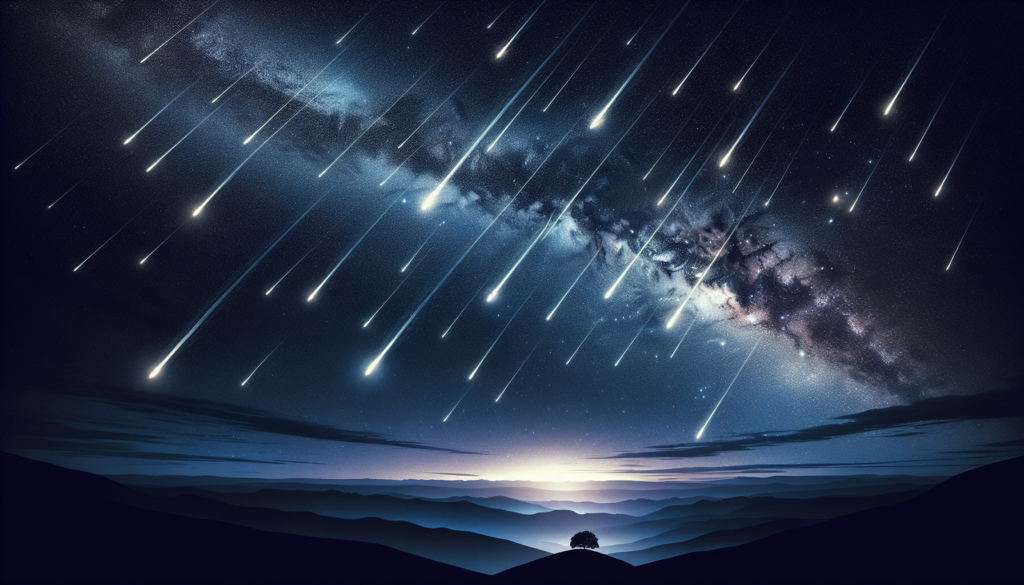
 ## The Stunning Perseid Meteor Shower: A Summer Evening’s Marvel
## The Stunning Perseid Meteor Shower: A Summer Evening’s Marvel
Every summer, sky watchers and astronomy aficionados eagerly look forward to the arrival of the Perseid meteor shower, a cosmic event that guarantees a mesmerizing spectacle of shooting stars. This year, the Perseids will hit their peak late Sunday night into the early morning hours of Monday, providing an excellent chance to witness one of nature’s most awe-inspiring light displays. Let’s explore the intricacies of this yearly event and find out how you can fully enjoy this astronomical wonder.
What Exactly Are the Perseids?
The Perseid meteor shower is a yearly occurrence that transpires when Earth travels through the remnants left by the comet Swift-Tuttle. As these minuscule particles enter Earth’s atmosphere, they incinerate, producing brilliant streaks of light that we perceive as meteors or shooting stars. The Perseids are famous for their frequency, with up to 100 meteors visible each hour at their zenith.
The Science Behind the Phenomenon
The Perseids are not merely any meteor shower; they are celebrated for their remarkable fireballs. As stated by NASA, “fireballs are larger bursts of light and color that can linger longer than an average meteor streak.” These fireballs result from larger clumps of cometary debris, leading to more intense and colorful exhibitions.
When and Where to Observe
To experience the Perseids at their finest, seek a spot with unobstructed, dark skies away from urban illumination. The peak viewing window is late Sunday night extending into the early morning hours of Monday. No specific tools are required to appreciate the show; the meteors can be seen with the naked eye. For the best experience, wait until after the moon has set to minimize light interference.
Suggestions for an Unforgettable Viewing Experience
- Select the Ideal Location: Find an area with low light pollution. Parks, countryside spots, or elevated terrains away from city brightness are perfect.
-
Get Comfortable: Bring a blanket or reclining chair for a cozy viewing experience. The spectacle can last for several hours, so being comfortable is important.
-
Exercise Patience: Your eyes may need some time to adjust to the darkness. Allow at least 20 minutes for acclimatization.
-
Review the Weather: Clear skies are crucial for a successful viewing experience. Check the weather forecast ahead of time to prepare accordingly.
The Legacy of Comet Swift-Tuttle
Comet Swift-Tuttle, the origin of the Perseid meteor shower, is a periodic comet with a 133-year orbit around the sun. Discovered in 1862, it last passed near Earth in 1992 and is expected to return in 2126. Its debris trail is what produces the yearly Perseid meteor shower, making it a key player in one of the most celebrated meteor showers of the year.
Conclusion
The Perseid meteor shower is an astronomical event that enchants viewers across the globe with its spectacular display of meteors and fireballs. Whether you are a space enthusiast or simply searching for a magical night beneath the stars, the Perseids provide a unique opportunity to connect with the universe. So, grab a blanket, locate a dark area, and get ready to be dazzled by nature’s fireworks.
Q&A: Your Questions About the Perseid Meteor Shower Addressed
Q1: Do I require any special tools to observe the Perseid meteor shower?
A1: No special tools are necessary. The meteors are visible to the naked eye, so just find a dark location and look skyward.
Q2: What is the optimal time to view the Perseids?
A2: The ideal time is late Sunday night through the early morning hours of Monday, preferably after the moon has set to ensure maximum darkness.
Q3: How many meteors can I anticipate seeing?
A3: During its peak, the Perseid meteor shower can yield up to 100 meteors each hour.
Q4: What are fireballs, and how do they differ from typical meteors?
A4: Fireballs are more extensive bursts of light and color that last longer than standard meteors. They originate from larger pieces of cometary material.
Q5: Is it possible to photograph the Perseid meteor shower?
A5: Yes, with the appropriate equipment. A camera with manual settings, a tripod, and a long exposure can effectively capture the meteors.
Q6: Is the Perseid meteor shower observable worldwide?
A6: The Perseids are most effectively viewed in the Northern Hemisphere, but some meteors may also be visible in the Southern Hemisphere.